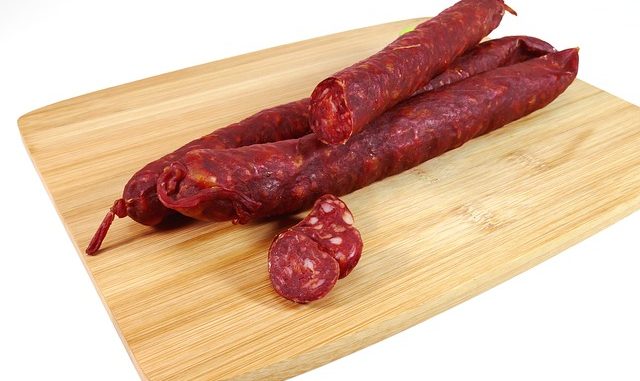
Chorizo is the classic fermented, cured and smoked sausage of Spain. Alexandre Dumas, the great French novelist, toured Spain in 1446 to 1847 and wrote at great length about Spanish cuisine. He exclaimed:-
“In every respectable household in Spain, they make as many chorizos as there are days in the year: 365 sausages for their own consumption and 50 more for days when they have guests.”
The chorizo originated in the region of Extramadura. Nestor Lujan who was a great authority of gastronomy wrote about a letter from a priest from Badajoz sent in 1576 who used the word chorizo for sausage.
The sausage was probably made using pig intestines as the casing from Roman times but the classic deep red colour comes from the use of dried and smoked red peppers or pimento which undoubtedly appeared following the Spanish conquest of Southern America.
Galician chorizo hails from northwestern Spain. Like other chorizos it is usually eaten soon after manufacture if it is not process packaged. To extend its shelf-life, some producers will vacuum pack the sausage. Other alternative approaches to extending shelf-life include storage of chopped chorizos in vegetable oil such as olive oil or sunflower oil or completely covering it in pork fat..
Spanish chorizo is made from coarsely chopped pork and pork fat, seasoned with garlic, oregano, some pepper such as pimento and salt. There are many regional varieties. It belongs to the group of dry fermented sausages.
The sausage is usually eaten uncooked and sliced. Many chefs use it to flavour a variety of dishes that call for some smoky port flavours. Its production is most unlike other fermented sausages which rely in part of the addition of sugars such as glucose and sometimes lactose. The Spanish manufacturers usually rely on fermentation without any added sugars.
Chorizo is now made in various forms around the Hispanic world including Mexico. The main ingredients of a typical Mexican-style chorizo include the Huasteco chorizo. This is prepared from minced pork and fat, salt, dry chilies and paprika, vinegar, and a mix of several spices. It is a high acid sausage. Chorizo Huasteco is typically produced at small plants or butchers and its manufacture is differentiated from other chorizos, i.e. after stuffing in natural casings sausages, these are tied into short segments (5-10 cm long) by means of small strips made from dry husks (special leaves that protect the ear of the corn plant). The sausages are dried for a few days at room temperature, and at the moment of purchasing in the market sausages are wrapped with banana leaves, instead or paper or plastic.
The Aroma of Chorizo
The aroma of chorizo is based on the lipids that are broken down by microorganisms and by a variety of autooxidation reactions. One can find straight chain alkanals, 2-ketones, and alcohols such as I-octen-3-ol. Most of the volatile compounds have been identifoed using straight forward gas chromatography/mass spectrometry (GC/MS) (Mateo & Zumalacarregui, 1996).
References
Mateo, J., & Zumalacárregui, J. (1996). Volatile compounds in chorizo and their changes during ripening. Meat Science, 44(4), pp. 255-273 (Article). .

Leave a Reply